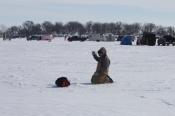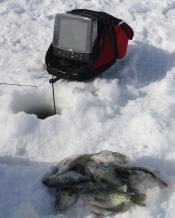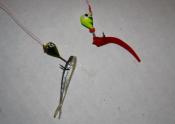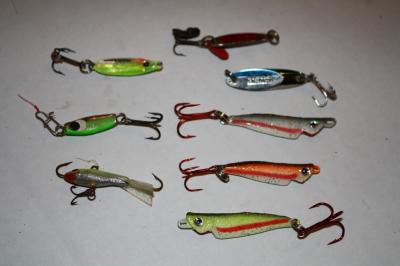 It’s been awhile since I’ve posted a report, and had some time to reflect upon the little things that have made such a difference over this chilly winter. Many times this winter I have felt like I was in the middle of a snooze fest, just doing the same old thing. But after a closer look, I it’s easy to see a few key things that have consistently put more fish on the ice for me. So rather than just spewing out another generic report of catching fish, I want to take some time to look at subtle details that trigger neutral panfish into active fish.
It’s been awhile since I’ve posted a report, and had some time to reflect upon the little things that have made such a difference over this chilly winter. Many times this winter I have felt like I was in the middle of a snooze fest, just doing the same old thing. But after a closer look, I it’s easy to see a few key things that have consistently put more fish on the ice for me. So rather than just spewing out another generic report of catching fish, I want to take some time to look at subtle details that trigger neutral panfish into active fish.
First and foremost, is locating panfish that are willing to eat. “No Kidding” is most likely the first thought that comes to mind. But throughout this winter I have witnessed numerous people that set up camp on the first fish they marked. The first key in locating fish is to understand when it is time to say “When”. No doubt that it’s easy to say they are here, but have you found the ones that can be tempted? Most of my panfishing this year has been in the basin of Fox lake, WI. A high pressure fishery amongst a high volume of fish. But not all schools are created equal.
In my first step of locating, here is what I do:
Preparation – Mindset has to be the first thing you develop. Knowing you are going to run & gun must be a game plan you’re willing to stick with. From there, I set my equipment of for efficiency. This winter has allowed me to drive my truck to more places than in the past, so I’ve taken advantage of a few things. All my rods are rigged with my search tools and placed on the dash. The LX-9 is my go to with other locaters conveniently located at easy access. The auger has a place unobstructed for easily sliding in and out of the bed of the truck. I state this only because of how I see so many guys “organizing” their equipment for travel, but not for easy access. Over the course of a day, I see hours lost to digging and searching for stuff.
Reading the school – In the case of Fox Lake, it’s not hard to find a school of fish. But finding the one you want normally takes some effort. I get excited when I see 2-3 feet thick of fish cruising off the bottom. Like any school, the higher in the column usually indicates a higher level of activity – but not always. So, having multiple rods pre-rigged, I’m able to get a pretty quick pulse of the fish’s mood. Our natural desire to get bait down quickly is sometimes our worst enemy when trying to decipher the code. I like a moderate fall and pay close attention to individual fish within a school. I want to see fish rise up to take a look while the bait is falling. Or to see a fish follow as it passes down through the school….Many times having the infamous “looker”. But this makes better use of my time. If I pass my 3 primary baits through a school within a couple minutes and they don’t turn on with any activity, SAY “WHEN” and move! Much too often hours can pass by while beating yourself up trying to get negative fish to become neutral. The idea is to go active!
 I always start with the most aggressive baits – spoons, jig raps, and other assorted hard baits. I very seldom make more than 5 or 6 unsuccessful passes into a school without changing. Again, it comes to using your time wisely. If they don’t follow or show signs that they will cooperate, change! With spoons, I like to slow fall them into a school. Fight the urge to plop it right down there. If fish are 16 feet down, I like to pause it by 10 feet, 12’, 14’ and 15’. If you hit the right bait/action, it is not uncommon to have crappies rise up 6 to 8 feet to hit it on the fall. Just an observation from over the years – I have more crappies rise up to hit on the fall than crappies that will chase a bait down to hit once it passes beneath a school.
I always start with the most aggressive baits – spoons, jig raps, and other assorted hard baits. I very seldom make more than 5 or 6 unsuccessful passes into a school without changing. Again, it comes to using your time wisely. If they don’t follow or show signs that they will cooperate, change! With spoons, I like to slow fall them into a school. Fight the urge to plop it right down there. If fish are 16 feet down, I like to pause it by 10 feet, 12’, 14’ and 15’. If you hit the right bait/action, it is not uncommon to have crappies rise up 6 to 8 feet to hit it on the fall. Just an observation from over the years – I have more crappies rise up to hit on the fall than crappies that will chase a bait down to hit once it passes beneath a school.
The popularity of using plastics is increasing every year and with good reason. The assortment of good baits continue to grow. Compared to only presenting a wax worm or minnow with the single variable of jig color, we now have 1000’s of combinations available. Rather than getting too caught up in the many possibilities, I try to keep it narrowed down to just a few. No different than plastics for walleye, bass, or any other species, I want to cover a spectrum without driving myself nuts. I relate a few colors to bottom content and water clarity and use that as my starting points. In general, mud flats and muck or fertile water types will do well with Blood Red and yellows/chartreuses. Clear water, solid bottoms, or weeds will often be better for purples, white, black, and natural colors. Not an exact science for everyday but these have been my general starting colors. Then I consider sun light penetration, morning, noon time…..to apply history for what my changes will be.
 Very much like a spoon, I work most of my plastics in a similar method. I want a slower fall with pauses as it descends to the school. Once in the school, small quivers for subtle action with pauses. But one thing I think that often gets over looked is how the fish respond to the bait being pulled away. Most of the time, we wiggle the bait up to see if a fish rises. A technique I found works great for quicker reactions is what happens when you pull it away quickly. If they spook away, they are usually leaning towards a negative mood. But if the quick motion triggers them into a chasing mode, its usually a game on for triggering strikes as soon as you pause it.
Very much like a spoon, I work most of my plastics in a similar method. I want a slower fall with pauses as it descends to the school. Once in the school, small quivers for subtle action with pauses. But one thing I think that often gets over looked is how the fish respond to the bait being pulled away. Most of the time, we wiggle the bait up to see if a fish rises. A technique I found works great for quicker reactions is what happens when you pull it away quickly. If they spook away, they are usually leaning towards a negative mood. But if the quick motion triggers them into a chasing mode, its usually a game on for triggering strikes as soon as you pause it.
A final thought on plastics is the flexibilities in hooking methods. I think this often gets over looked way too much. All plastics can be presented differently and have different fall rates/actions by the way they are hooked. As an example, I had crappies snapping at a gulp 1” minnow, but the fall was too fast and most crappies would start to rise and it blew past them. I re-hooked it entering the top and out the side so it sat on more of an angle. On the drop, it had a slow spiral and fell slower. A subtle thing, but it triggered a lot more bites.
A post like this can easily go on like a novel and quite honestly, I couldn’t sit and type any more….I have fish to clean. So on your next trip out, give those plastics a fair chance and don’t be afraid to experiment a little with the presentation. Not everyone will present them the same, and YOU need to find what works best with the school beneath you! Good Luck!

Another tactic I have grown very fond of is weighted stone flies. Using patterns from our fly fishing friends, I’ve adapted some lead wire wrap inside of a couple patterns and found they are dynamite!
a few more pics
Heck of a report! and great tips!
Great report Randy. People sure do have different styles of fishing. That plopping down in a fish house seems more like hanging out than fishing. Then again I think many of those guys are staring at us hole hoping out on the ice think those poor saps cant afford a fish house.
Very nice,and well written.thanks Randy
I think you are right! but I’d rather hop around and catch fish than sit in a warm shack and stare at a blank flasher. Our lakes rarely have roaming fish, mostly just scattered around so the only true way to get a decent amount of action is to hop. I often wonder how many times people have watched me hopping around in single digit temps thinking I’m nuts.
Thanks so much for sharing some of your insights Randy. I always love reading your reports, both here and on the hunting side, because of the excellent job you do breaking down the details… You’re a bit of a mad scientist and I mean that in a VERY complimentary fashion
Thanks guys
Mike, I couldn’t tell you how many times I watched a heat plume roll out of a shack and wished I could step in to warm up. Yet I see that many times they caught much less
Nice read Randy.
I get to Fox maybe twice a year, and always work to find fish towards dusk…. and hope to find a home to set up the shack as it gets darker. I for the most part, never figure out how from dusk to whenever in the night, all these fish I couldn’t find during the day just seem to show up. And they want to eat. Catch a few and it gets quiet… drop a different jig down, and it can start all over.
Hope to get up one more time this year… have to admit, hole hoping gets a little tougher when there is “really” think ice.
Thanks again for the write-up.
Great report bud

It CAN be hard to keep up you with at times
CC- just my theory. Through out the day on Fox and other lakes, you find many negative schools or fish hugging the bottom. Those fish that didn’t feed through out the day are the ones that are turning on. Nagawicka by me is notorious for that. Don’t mark a single fish for hours and then around 9pm, schools seem to just appear. After searching more with a camera, I found schools tight to the bottom that were extremely negative.
Your thought process sounds spot on… never really thought about it that way, but makes sense. Years ago I ran into the same thing in the kettle… hour after dark, it was, where did all these come from.
Thanks for the postings again.
Hhhmmmm….you must have been one of the few guys we fished amongst in there

Great report Randy and way to think outside the box. Started my ice fishing career on pan fish and still have a soft spot for fishing them. Wish we had some good pan fish lakes in our area most of the pan fishing is in WPA Dams or stock dams.